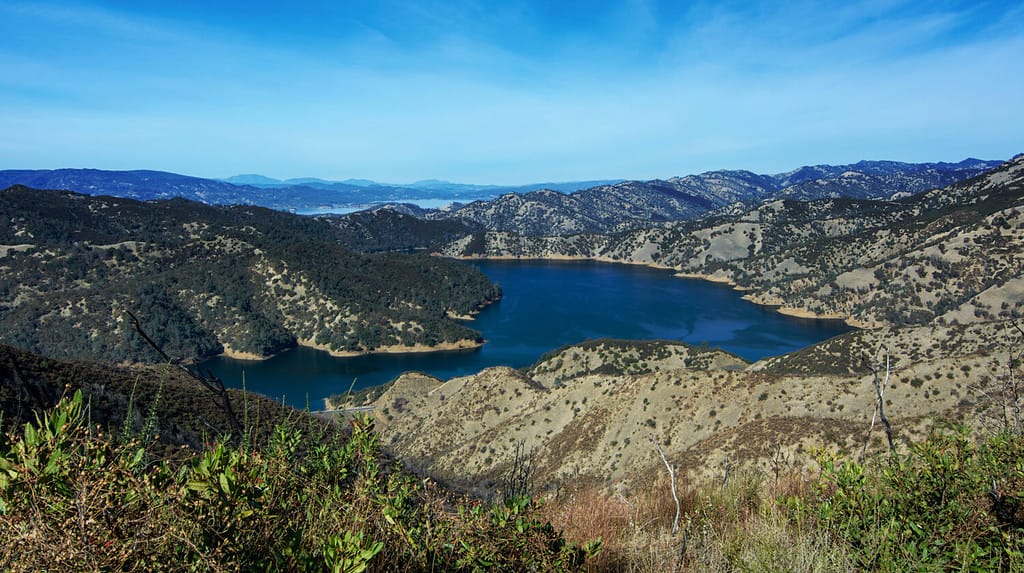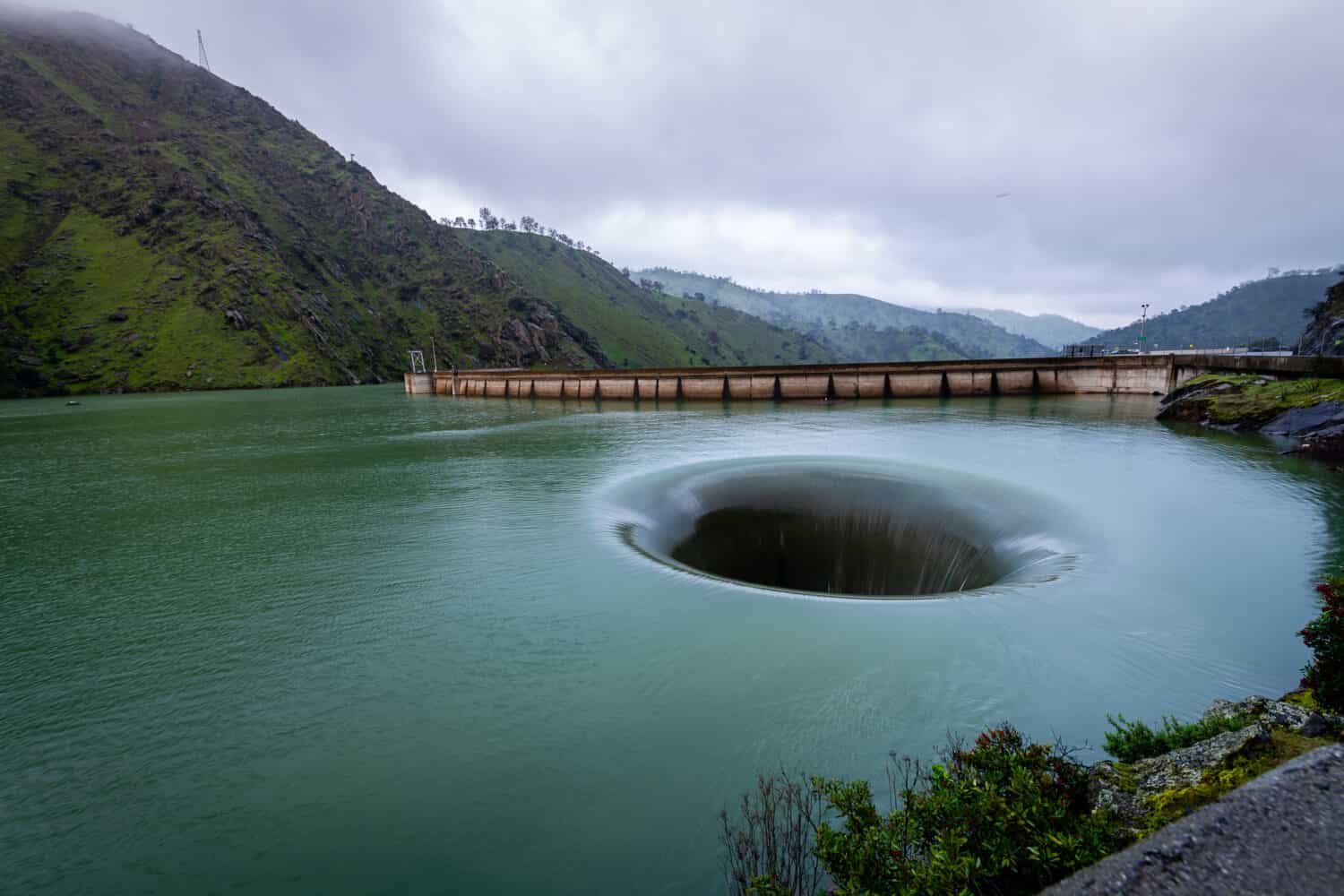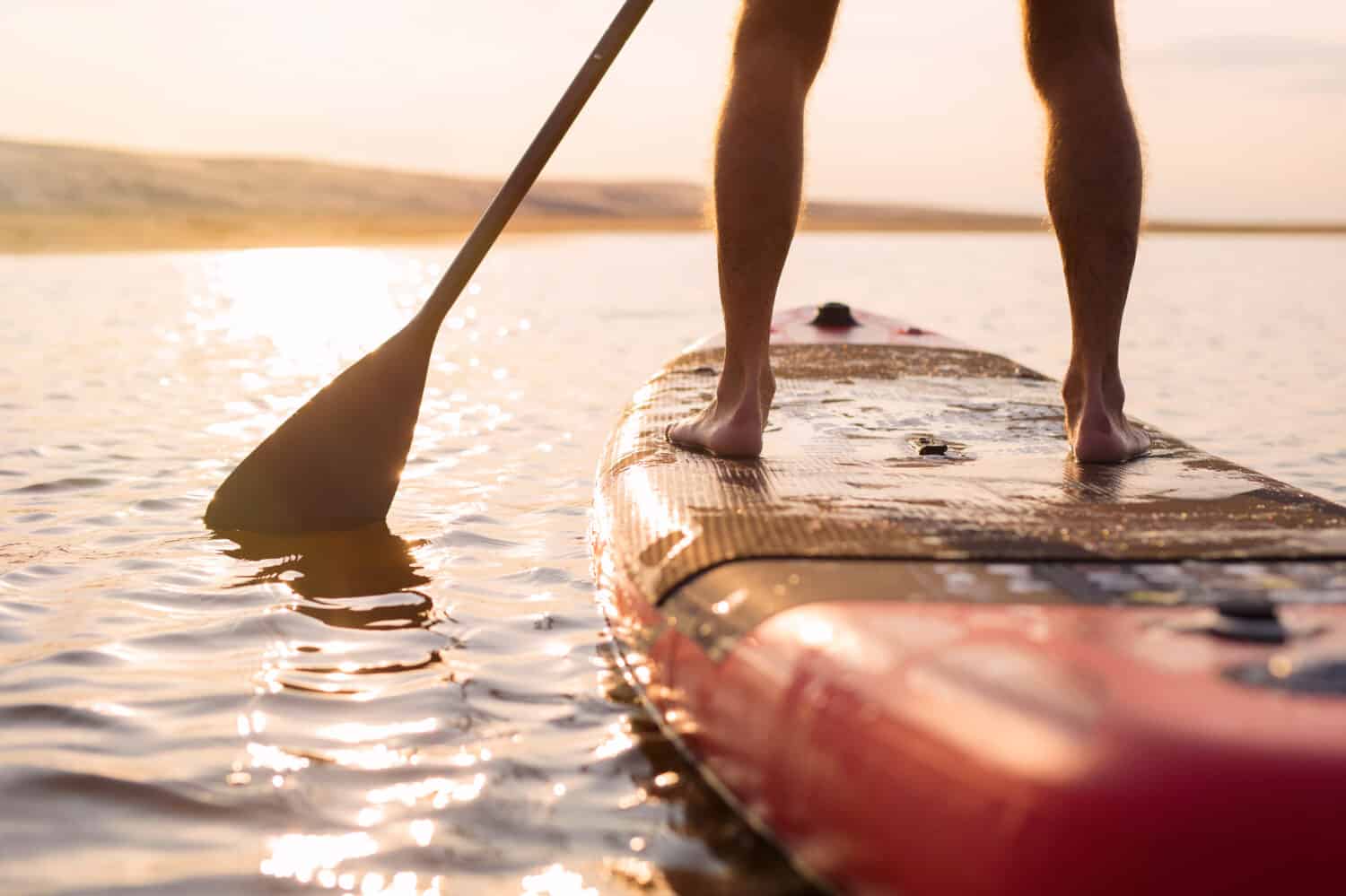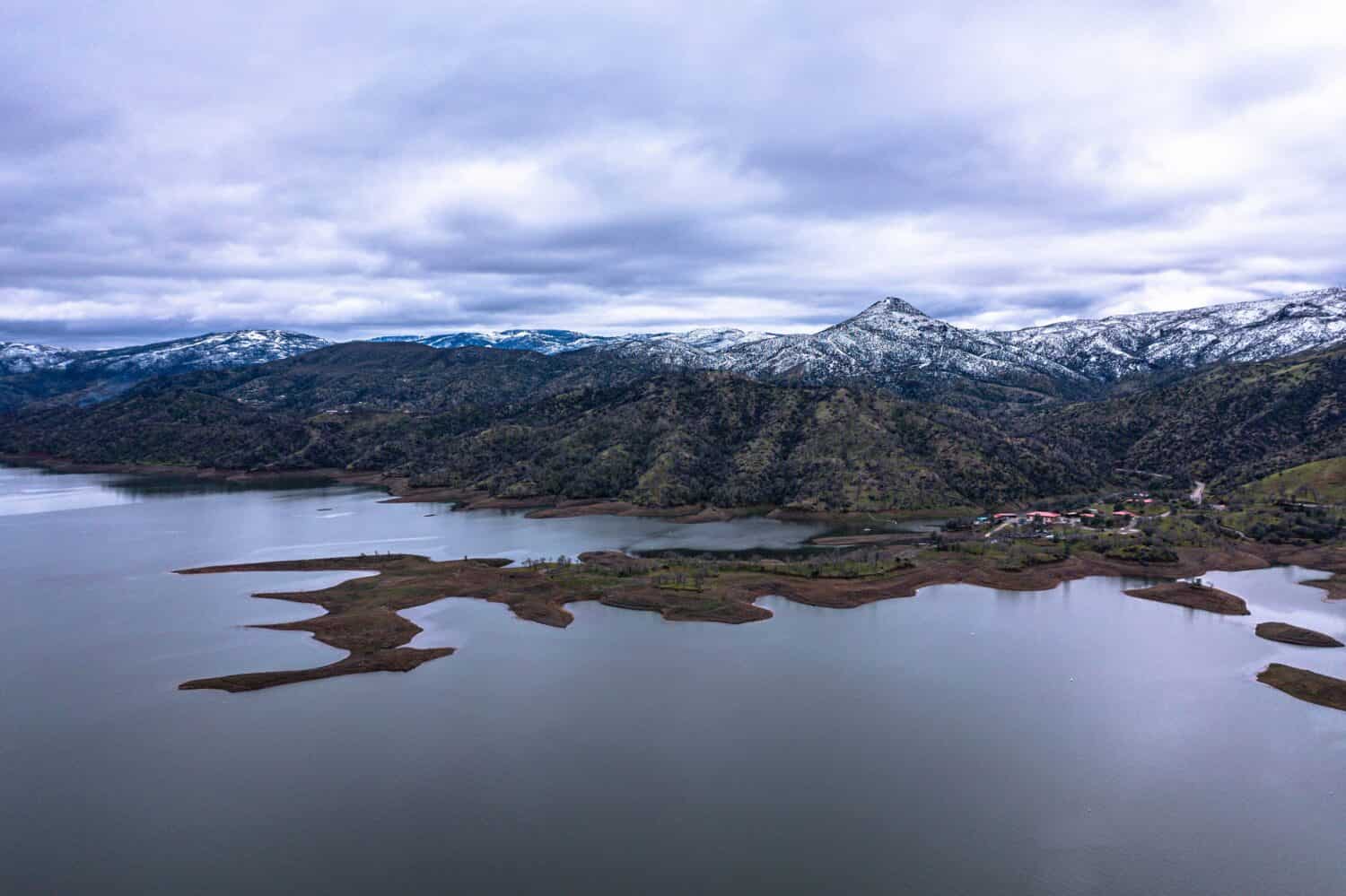Lake Berryessa resides in the Vaca Mountains amidst the picturesque landscapes of Napa County, CA. This reservoir is more than just a serene setting for outdoor activities. Along with its interesting history, certain counties utilize the water for municipal, agricultural, and industrial purposes. This article will explore how deep Lake Berryesa is, its size, its history, and what it is known for, amongst other facts.

Lake Berryessa, well full, has a surface area of over 20,700 acres (83.8 square kilometers), a length of over 15.5 miles (24.9 kilometers), and a width of over 3 miles (4.8 kilometers).
©Sundry Photography/Shutterstock.com
How Deep is Lake Berryessa?
The lake’s depth varies across its expanse. At its deepest point, Lake Berryessa’s maximum depth plunges to an incredible 275 feet (approximately 84 meters).
Lake Berryessa winds its way through the rugged region of this Californian landscape. The lake’s maximum length measures approximately 15.5 miles (24.9 kilometers). This expanse provides ample opportunities for recreational activities such as boating, fishing, other water activities, and lakeside camping, making it a cherished destination for outdoor enthusiasts.
In terms of width, at its maximum width, the lake spans approximately 3 miles (4.8 kilometers). This breadth contributes to its unique topography and creates a diverse range of habitats for both aquatic and terrestrial life.
The surface area of Lake Berryessa is a key metric. When at full capacity, this sprawling reservoir covers over 20,700 acres (83.8 square kilometers). This vast expanse of water serves as a scenic backdrop for the surrounding communities and a vital resource for the region. Moreover, considering its large size, its shoreline extends upwards of 165 miles (266 kilometers)
Furthermore, Lake Berryessa is a monomictic lake, meaning the waters of the lake turnover once a year, usually in the autumn. As the upper water temperature cools to match the lower water temperature, water can circulate easily throughout the lake, replenishing oxygen to oxygen-deprived areas and allowing fish to roam anywhere throughout the lake.

Lake Berryessa is located in northern California, about 44 miles west of Sacramento.
©AlessandraRC/Shutterstock.com
How Did Lake Berryessa Form?
This man-made lake was constructed in the 1950s when a project was initiated to address the region’s water needs. The primary objective was to provide a reliable water source for agriculture, municipal use, and flood control.
Lake Berryessa is a reservoir. Reservoirs are distinct from natural lakes in that human activity creates or modifies them for specific purposes, such as water supply, flood control, or hydroelectric power generation. Lake Berryessa is a part of the Solano Projects, where it is the largest and most well-known project. It was intentionally created by impounding or damming Putah Creek.
The dimensions of Lake Berryessa are inextricably linked to the engineering feats that brought it into existence. The Monticello Dam, standing at a towering 304 feet (93 meters) in height, is why the lake exists. In 1953, construction crews began building the concrete arch dam to impound Putah Creek, consequently flooding the valley in the Vaca Mountains area. They completed the dam in 1958. By 1963, the reservoir had filled with water. At the time, it was the second-largest man-made lake, next to Shasta Lake. As of 2023, it is the seventh-largest man-made lake in the state of California.
Furthermore, they named the dam after the town that resided in the valley before the dam’s construction, Monticello. To create the dam and, consequently, the lake, they had to abandon the town. Famous photographers Dorothea Lange and Pirkle Jones documented this process at the time.
Water Sources of Lake Berryessa
Moreover, the environment plays an equally crucial role in shaping the lake’s dimensions. Its primary water source consists of the headwaters of the Putah Creek watershed, in addition to the three tributaries of Pope Creek, Capell Creek, and Eticuera Creek. Each tributary has different flow rates and locations, which contribute to the difficulty of estimating the lake level rise. The delicate balance between human engineering and natural forces underscores the complex interplay of factors that define Lake Berryessa.
The Lake Berryessa Glory Hole Spillway
Furthermore, the engineering feat of Monticello Dam and the resulting Lake Berryessa has profoundly impacted the region’s water management, agriculture, and recreation. The dam is equipped with an open bell-mouth spillway known as the “Glory Hole” or “Morning Glory Spillway,” which serves as both a practical water release mechanism and a unique spectacle. In times of heavy rainfall, excess water is channeled through this circular spillway, resembling a massive drain, creating a mesmerizing vortex that draws in onlookers and photographers. However, this feature is not without its risks and is carefully managed to ensure public safety.
Purposes of Lake Berryessa
One of the primary purposes of Lake Berryessa is to serve as a reliable water supply for predominately Solano County, with minuscule use within Napa County. The Lake stores water from seasonal rains, ensuring a consistent source of water for agricultural, municipal, and industrial use.
Beyond its utilitarian functions, and though it was not intended for this use, Lake Berryessa offers a haven for outdoor enthusiasts as a recreational hotspot amongst serene nature. Its extensive shoreline and waters provide opportunities for boating, fishing, waterskiing, paddleboarding, camping, wildlife observation, and much more. The lake’s recreational attributes make it a cherished destination for both locals and visitors.
Finally, Lake Berryessa also plays a role in generating clean energy. The flow of water from the lake through turbines in the Monticello Dam generates hydroelectric power, contributing to the region’s energy needs.

The Monticello Dam, which was constructed to create Lake Berryessa, has a large open bell-mouth spillway called the Morning Glory Spillway, or Glory Hole for short. This spillway serves to empty water back into Putah Creek when water levels of the lake reach a certain height.
©Chris LaBasco/Shutterstock.com
What is Lake Berryessa Known For?
Besides its agricultural, municipal, and industrial water uses, Lake Berryessa is known by most for its beauty, recreational opportunities, and intriguing history. With its scenic beauty, diverse activities, and captivating destinations, it invites locals and visitors alike.
Water Recreation
Lake Berryessa is synonymous with water-based activities that cater to every taste. The expansive waters of Lake Berryessa invite boaters of all kinds to explore its expanse and various islands. Whether rowing, kayaking, canoeing, paddleboarding, powerboating, or simply cruising on a pontoon or fishing boat, the lake provides an aquatic playground for all. On hot summer days, the lake offers a refreshing natural pool for swimmers. Thrill-seekers can experience the rush of gliding across the lake’s surface by maneuvering at exhilarating speeds. Waterskiing, wakeboarding, tubing, jet skiing, and the like are extremely popular activities on this lake. While paddle enthusiasts can peacefully traverse the lake’s calm waters, taking in the serene beauty of its surroundings. One example is paddleboarding, which is a tranquil way to slowly savor the lake’s beauty while getting a great workout.
Furthermore, below the surface, Lake Berryessa hides a submerged experience. Divers and scuba divers can explore its depths, uncovering underwater landscapes. Anglers are drawn to the lake’s bounty of fish, including panfish, bass, catfish, salmon, and trout. Casting a line from the shore or a boat promises an enjoyable day of fishing. However, due to the lake’s turnover period, autumn can be a tricky time for fishing. For a unique perspective, Lake Berryessa is a popular lake for seaplanes in the area to land on the lake’s surface, providing an unforgettable experience for passengers.
Land Recreation
Lake Berryessa’s natural splendor extends beyond its waters as well. The surrounding landscape hosts a network of trails for hikers of all levels. Berryessa Peak Trail and the Native Plants and Native People Interpretive Trail, in particular, reward hikers with sweeping views of the lake and its environs. Moreover, campsites at the Pleasure Cove Marina, Putah Canyon Campground, Spanish Flat Campground, and Steele Canyon Campground offer the opportunity to sleep lakeside in your text or RV, awakening to the serenity of the lake.
Moreover, ornithophiles, or bird lovers, can delight in the lake’s avian residents and migratory visitors. Keep an eye out for majestic gold eagles, ospreys, and an array of waterfowl. On a related note, Lake Berryessa is not just about birds. The area surrounding the lake hosts a diverse array of wildlife, including black-tailed deer, western rattlesnakes, mountain lions, foxes, rabbits, squirrels, and even the occasional bobcat.
Destinations
Lake Berryessa is dotted with destinations surrounding the lake that offer a multitude of experiences and opportunities. First, the iconic Monticello Dam stands as a testament to engineering ingenuity and is an impressive sight to witness. The nearby Glory Hole spillway, an unusual sight, draws spectators during periods of heavy rainfall. Second, the Markley Cove Resort is a popular launching point for boaters and a lakeside resort offering various amenities and a relaxed atmosphere. Moreover, Pleasure Cove Marina is a hub for water sports and rentals. Pleasure Cove Marina provides easy access to Lake Berryessa’s aquatic adventures. Third, the Oak Shores Day-Use area features picnic facilities and access to the lake’s shores, making it an ideal spot for a leisurely afternoon by the water. Fourth and finally, Lake Berryessa has many islands, including Big Island, Small Island, and Goat Island, each adding to the lake’s unique allure.
Other Interesting Facts About Lake Berryessa
Lake Berryessa harbors an interesting history. Lake Berryessa gained a different kind of notoriety in 1969 when it was linked to the infamous Zodiac Killer, who carried out a brutal attack near the lake. Moreover, the lake is home to both cold-water and warm-water fish, providing many fishing opportunities. Before the lake’s creation through the Monticello Dam, it was a landscape with canyons and a valley. Furthermore, natural beauty surrounds the lake with verdant hills, forests, various communities, and sprawling vineyards.
Lake Berryessa is a multifaceted destination that embodies the harmony of nature and recreation. Its vast range of water sports, scenic beauty, hiking trails, and intriguing history offer a little something for everyone. Whether you seek adventure on the water, tranquility in nature, or simply a place to unwind, Lake Berryessa is a prime destination in Napa County.

Lake Berryessa is a destination in northern California for water-based recreation.
©Kaspars Grinvalds/Shutterstock.com
Animals Found In and Around Lake Berryessa
Lake Berryessa, cradled amidst the scenic beauty of Napa County, California, is not just a reservoir of water; it’s a reservoir of life. The surrounding landscapes, hills, and waters are home to diverse animals, each contributing to the tapestry of biodiversity that thrives in this region. In this exploration, we delve into the remarkable creatures that call Lake Berryessa and its environs their home and briefly touch upon the plants that flourish in this natural haven.
Avian Animals
Lake Berryessa is a haven for birdwatchers, where the skies and shores come alive with avian activity. Majestic bald eagles grace the skies above Lake Berryessa. These iconic raptors are a symbol of the region’s natural beauty and the health of its ecosystems. With their distinctive white heads and keen eyes, ospreys are also a common sight around the lake. They have remarkable fishing skills, swooping to catch fish from the lake’s clear waters. Alongside bald eagles, golden eagles soar in the skies over the lake, showcasing their impressive wingspans and powerful hunting prowess. Turkey vultures are large, graceful birds that you can often see riding the thermals above the lake, scanning for carrion. You can also spot white pelicans around the lake, particularly near secluded islands.
Moreover, Lake Berryessa also hosts a variety of waterfowl, including Canada geese, mallards, and great blue herons. The tranquil waters provide an ideal setting for these feathered residents. The vibrant blue plumage of western bluebirds adds a splash of color to the lake’s surroundings. You can often see them perched on tree branches, shrubs, fence posts, and utility wires. Lastly, during the migratory seasons, Lake Berryessa becomes a stopover point for a wide range of birds traveling along the Pacific Flyway. Birdwatchers eagerly seek out the arrival of these transient guests.
Aquatic Animals
Beneath the surface of Lake Berryessa lies a world teeming with aquatic life. Largemouth bass are voracious predators and are prized by anglers for their size and fight. Smaller than their largemouth cousins but just as fierce, smallmouth bass are another popular catch in the lake. Spotted bass have distinctive markings and are a sought-after species for sport fishing. With their distinctive whiskers, also known as barbels, channel catfish are a common species in the lake and offer a delicious catch. Bullhead catfish are a smaller catfish species that also reside in the lake, adding to the diversity of the aquatic ecosystem. White catfish also contribute to the variety of catfish species inhabiting the lake.
Furthermore, carp, which are quite adaptable, are a common sight in Lake Berryessa’s waters. The Sacramento pikeminnow are native fish that are also part of the lake’s aquatic biodiversity. Crappies and bluegills have distinct markings and are popular targets for anglers. They are common panfish species that reside in the lake. Moreover, Rainbow trout, brook trout, and brown trout are often stocked in the lake, providing opportunities for trout fishing. Finally, a landlocked variety of Pacific salmon, including kokanee and Chinook salmon, add to the unique diversity of fish in the lake.
Lastly, in the lake’s clear waters, a plethora of aquatic invertebrates, such as crawfish and freshwater mussels, are a part of the ecosystem. You may encounter various amphibians along the lake’s shoreline, including Pacific tree frogs and western toads. They add their chorus to the symphony of lake sounds.
Terrestrial Animals
The hills and woodlands surrounding Lake Berryessa are home to a range of terrestrial animals. Although elusive, mountain lions roam the region, playing a crucial role as apex predators in the ecosystem. Black-tailed deer are a graceful and common sight, feeding on the vegetation around the lake’s wooded areas. While not often encountered, western rattlesnakes are native to the region, occupying a niche as predators of rodents. Raccoons are frequent visitors, known for their adaptability and distinctive markings. Skunks make their homes in the woodlands and grassy areas, where they forage for insects and small prey. Wild turkeys also thrive here. You can spot these large birds foraging for food in the open grasslands and wooded areas.
Furthermore, various rabbit species inhabit the region, contributing to the local food web. Coyotes are adaptable canids roaming the region, their distinctive calls sometimes echoing across the lake at night.
Bobcats are elusive and solitary creatures, but lucky observers might catch a glimpse of these feline hunters prowling through the wooded terrain. At dusk, bats emerge from their roosts in search of food, such as insects, contributing to natural pest control around the lake. While not as common, other reptiles like garter snakes and western pond turtles do reside around the lakeside habitats.
Plants
While Lake Berryessa is predominantly a freshwater haven, the surrounding areas are lush with flora. Valley oaks are stately trees that are a hallmark of the California landscape, providing shade and habitat for a variety of wildlife. The rolling hills around the lake are often adorned with chaparral, a type of shrubland. Sargent cypress are striking conifers, with their distinctive blue-green foliage, thrive in the region’s woodlands. Riparian areas around the lake often have cottonwoods and white alder trees, which provide critical habitat for various wildlife species. Leather oaks add to the diversity of the woodland vegetation.
Furthermore, vibrant wildflowers paint the landscape with yellow, orange, and purple hues during the spring and early summer. Lupines, Bridges’ brodiaea, and poppies are common species to look out for. Many of these plants provide critical habitat for birds and other wildlife.

Lake Berryessa is a reservoir and monomictic lake, meaning it is a man-made lake, and the waters of the lake turnover once a year.
©Adam Derewecki/Shutterstock.com
Where Is Lake Berryessa Located on a Map?
Lake Berryessa is situated in Napa County in northern California, near the towns of Napa, which is southwest, and Winters, to the east. It is also situated between the cities of Sacramento to the east by approximately 44 miles and Santa Rosa to the west by about 44 miles.

The maximum depth of Lake Berryessa is approximately 275 ft (84 meters).
©Jack Mast/Shutterstock.com
Conclusion
In conclusion, Lake Berryessa is approximately 275 ft (84 meters) deep at its maximum depth. This reservoir is a remarkable testament to the coexistence of nature and human innovation. It was brought into existence through the construction of the Monticello Dam and serves multiple essential functions, from a prominent water supply to recreation and power generation. This man-made lake represents the harmonious blending of human ingenuity with the natural beauty of California’s landscape.
The photo featured at the top of this post is © Adam Derewecki/Shutterstock.com
Thank you for reading! Have some feedback for us? Contact the AZ Animals editorial team.






